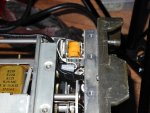k9rzz
Member
Okay, you're on the right track by focusing on the tubes at this point.
Have patience. You're still thinking that it's "A" problem, but in reality the radio probably has a number of problems that need to be fixed. Just like you're fixing up an old car, just do 'em one at a time and you'll get there!
Have patience. You're still thinking that it's "A" problem, but in reality the radio probably has a number of problems that need to be fixed. Just like you're fixing up an old car, just do 'em one at a time and you'll get there!





